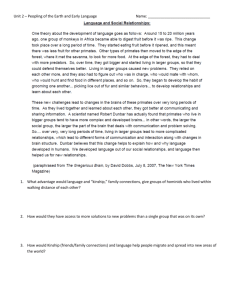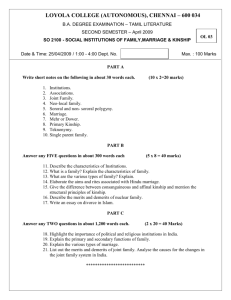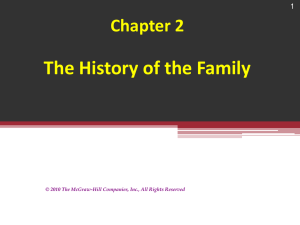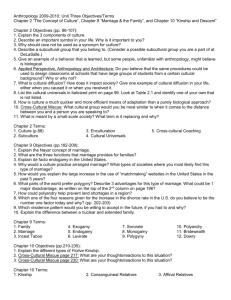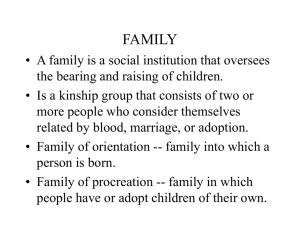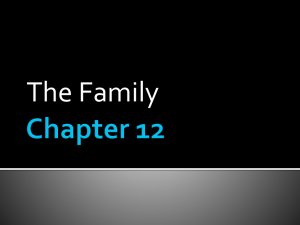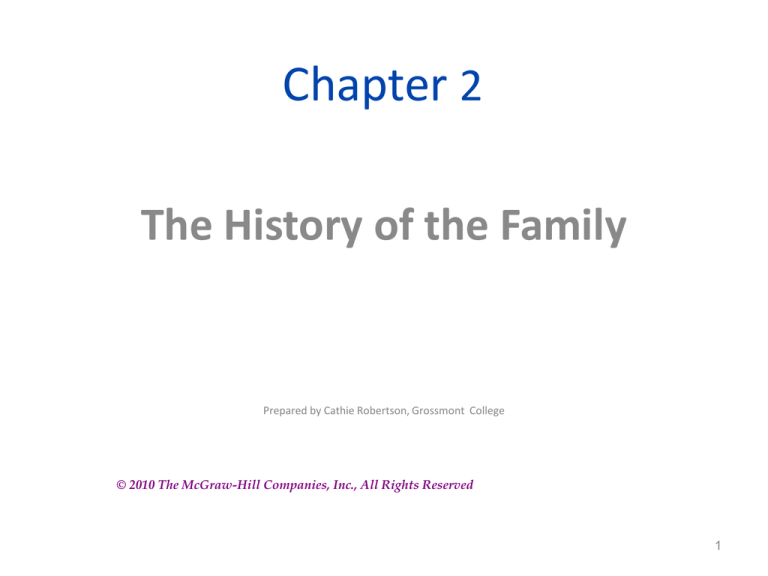
Chapter 2
The History of the Family
Prepared by Cathie Robertson, Grossmont College
© 2010 The McGraw-Hill Companies, Inc., All Rights Reserved
1
The Study of the Family
• Upper class bias of historians
– Studied kings, nobles, wars, rise & fall of
empires
• First, examination of “ordinary” families
– Began in 1960
2
Philippe Aries-- CENTURIES OF CHILDHOOD
•Institution of childhood began to emerge
• Situation of young began to change
• New term: “children”
•A theory of innocence of the child emerged.
• Children to be protected from adult reality
•The facts of birth, death, sex, tragedy, world
events hidden from the child.
3
Philippe Aries-- CENTURIES OF
CHILDHOOD
•Children increasingly segregated by age
•The fact of having an age became important
•In the "ancien regime" people’s ages were
virtually unknown
4
17th Century
5
18th Century
6
19th Century
7
19th Century
8
20th Century
9
Origins of Family and Kinship
Evolutionary theory—infants need care
Hunter-gatherers
Settled agriculture
Lineages: Form of kinship in which descent is
traced
Patrilineage: Father’s line
Matrilineage: Mother’s line
10
Origins of Family and Kinship (cont.)
Kinship Groups
Ensure order
Defend against outsiders
Provide labor
Assist others in group
Recruit new members
Through marriage
11
Origins of Family and Kinship (cont.)
• In most societies--smaller family units
–Mother and children always
–Husband/father (usually)
–Other household members
(sometimes)
12
Origins of Family and Kinship (cont.)
Western culture—smaller kinship groups
Conjugal family: Husband, wife and
children
Extended family: Other relatives in
household
13
Origins of Family and Kinship (cont.)
• Polygyny: One man, many wives
• Polyandry: One woman, more than one
husband
• Family and kinship systems developed to
provide fundamental needs:
–Food production
–Defense
14
Families Across Culture –
Na Kinship
• Brothers & sisters live in mother’s household for life
• Instead of taking wives, men visit women in other
households
– Visit any Na woman who consent to sex
• When children are born, they remain with mother
and maternal aunts and uncles
15
Families Across Culture –
Na Kinship
Fathers do not live with their children, but
they are a presence in their lives
After Communist Revolution in China,
government began to promote monogamy
among the Na – they resisted
Government eventually backed down
16
The American Family
before 1776
• American Indian Families
• European Colonists
• African Slaves
17
American Indian Families: The
Primacy of the Tribes
• American Indian - Indigenous people in the 48
territories that became United States
• Family units based on lineages
• Tribes, both matrilineal and patrilineal
–Matrilineal ties to maternal kin
–Patrilineal ties to paternal kin
18
European Colonists: The Primacy of the
Public Family
• Families performed public services
– Education
– Hospitals
– Houses of correction
– Orphanages
– Nursing homes
– Poor houses
19
European Colonists: The Primacy of the
Public Family (cont.)
• No room for privacy or private lives
–Family affairs are public business
–Houses not designed for privacy
–Little privacy from other households
–Conjugal family considered integral part
of society, not apart from it
20
European Colonists: The Primacy of
the Public Family (cont.)
• Family Diversity
• Not all families fit ideal of conjugal family
• Many stepfamilies due to deaths of parents
• Marriage not always official, could be
informal
–More common in Middle Colonies
–A form of bigamy if man migrated to West
and began a new family
21
The Emergence of the “Modern” American
Family: 1776 to 1900
• Four new characteristics:
1. Marriage—based on mutual respect and
affection
2. Wife cared for home and children—seen as
morally superior
3. Childhood as time to protect and support
children
4. Number of children per family declined
22
The Emergence of the “Modern” American
Family: 1776 to 1900 (cont.)
•
•
•
•
Individualism
Increase personal relationships in families
Emotional rewards
Autonomy
23
From Cooperation to Separation:
Men’s and Women’s Spheres
Change in the mode of production
– Commercial capitalism
– From “family labor” to “paid labor”
• Men worked outside the home
– Work governed by business ethic
– World outside the home
24
From Cooperation to Separation:
Men’s and Women’s Spheres (cont.)
• Women worked inside the home
– Women renew husbands’ character &
spirituality
– True womanhood where women were:
• Pious upholder of spiritual values
• Pure
• Submissive to men
• Domestic
25
Cult of True Womanhood
• http://www.youtube.com/watch?v=wtXNNAs9u
0M&feature=player_embedded#!
26
Happy Homemakers
27
African-American, Mexican-American, and
Asian Immigrant Families
• Africans forced to immigrate
– Captured or bought in West Africa
– Sold as slaves
• Asians work as laborers on railroads, etc.
28
African-American Families
• An African heritage?
–Historically maintained stronger ties to
extended kin
–Children before marriage
–Women worked
–African society was organized by lineages
• Marriage much more of a process
–Slavery stripped elders of authority
over marriage process
29
Impact of Slavery
• E. Franklin Frazier believed slavery had
destroyed social organization among slaves
• In 1976, Gutman found substantial
evidence that slaves often married for life,
and kept track of extended family
• Most families—two parents
• Black women—work outside the home
30
Mexican-American Families
• Mexicans settled frontier of N. Mexico
• Landowners & farmer-laborers, compadres
–Farmer-laborers—Mestizo—part Spanish
and part Native American
–Compadrazgo: In Mexico, the godparent
relationship of wealthy or influential
person outside the kinship group asked to
become compadres
31
Mexicans
Treaty of Guadalupe Hidalgo
• One of most far reaching treaties
of American history
• Signed on Feb. 2, 1848
• Ended the U.S.-Mexican War
• A war declared against Mexico by
the U.S. Congress on April 23,
1846.
32
Mexicans
Treaty of Guadalupe Hidalgo
U.S. took from Mexico the land area of:
Texas
New Mexico
California
Arizona
Nevada
Utah
Half of Colorado
33
Treaty of Guadalupe Hidalgo
• Treaty defined border between the United
States and Mexico
• Border has remained mostly the same
along the Rio Grande
(With the exception of the Gadsden Purchase called The Treaty
With Mexico of Dec. 30, 1853 and the purchase of Chamizal land
near El Paso, Texas)
34
Mexico & U.S. After Treaty
35
Mexican-American Families (cont.)
• Social structure disrupted by wars, revolts
and land grabs in 1830s and 1840s
• U.S. acquired by conquest the current
Southwestern U.S.
• Mexicans became more of a working class
• Many were forced into barrios:
– Segregated neighborhoods in U.S.
36
Mexican-American Families
• Five centuries of Spanish colonization
• Mexican contemporary family cultural
hybrid character, combines:
• Feelings of indigenous peoples
•Traditional feminine subculture
• And Spanish expectations and norms
• The masculine machista orientation
37
Mexican-American Families
• Estimated that 74.2% of contemporary
Mexican families are nuclear
• The rest are extended family types
Relations & structure appear to be nuclear
• In practice, they continue to be extended
• In fact, families give emotional & instrumental
support and guidance at all times.
38
Asian Immigrant Families
• The Asian Heritage
– Immigrants from China and Japan and
their descendents
– Family systems sharply different
• Fathers had authority over family
• Kinship—patrilineal
• Children expected to take care of elderly
and live with them
– Greater emphasis on family loyalty
39
Asian Immigrant Families (cont.)
– Few families, remittances, no citizenship,
discrimination
• Arranged marriages
– When Japanese migrated to Hawaii in
1880s, more balance of ratio of women
to men, so more families formed
– Figured out ways of building family-like
ties in U.S.
40
Asian Immigrant Families (cont.)
• Discrimination led to Japanese
internment camps—WW II
• 1965 Immigration Act changed
the restrictions that blocked
most Asian immigration and
substituted a yearly quota
– Asian population expanded rapidly
• 2000 census: 11.9 million Asian
Americans
– Filipinos bilateral kinship —both
sides
41
The Rise of the Private Family:
1900-Present
The Early Decades
• Rise in premarital sex, decline in
births, rising divorce rate,
“inappropriate behavior”—1920s
• Rise in marriage rate—greater
emotional satisfaction from marriage
42
The Rise of the Private Family:
1900-Present( cont.)
• Families becoming less of a
dominant force in people’s lives
– Marriage become less necessary
economically and materially
• Marriage become more fragile
43
The Rise of the Private Family:
1900-Present (cont.)
• Privacy and private families on increase
– Birthrate decline
– Adult life expectancy increased
– More apartments were built for
independent living
44
The Rise of the Private Family:
1900-Present (cont.)
• Basis of marriage—economics to
emotional satisfaction and
companionship
• Men and women—more
economically independent
• Marriage bonds weakened
– Divorce more common
45
The Depression Generation
•
•
•
•
Affected family finances
Undermined authority of father
Divorce rate fell
Postponement of marriage and childbearing
– 1 in 5 never had children (1 in 10 norm)
• Children helped out by working
46
The 1950s
• Baby boom renewed emphasis on marriage
and children
– Young adults from depression married
earlier and had more children than ever
before
– From a relatively small birth cohort
– Preferred family size shifted
• Highpoint of breadwinner-homemaker model
– Not really the traditional family
– Faded quickly
47
Figure 2.1
Percentage never married among men
and women aged 20 to 24
48
Figure 2.2
Percentage of children aged 0-17 living
in each of four types of families
49
1960s and Beyond
• Birthrate plunged
• Married on average 4-5 years
later than before
• Young people wanted
independence
• Divorce rate doubled 1960s–70s
– Declined slightly since then
• Cohabitation—1970s
• Women working outside home
50
Social Changes in the 20th Century
• Looking at Figure 2.3, show changes
in family and personal life
– Twentieth century—great change in
the kinds of family lives individuals lead
51
Figure 2.3
A life-course perspective on social change in the
20th century
52
Emergence of Early Adulthood
• Early adulthood – period between
mid-teens and about 30
• Labor force – all people who are
working for pay or looking for paid
work
53
The Role of Education
• Education – main factor in lengthening
of early adulthood
• More employment opportunities for
college-educated
• Young adults may still marry, but they
may postpone children to further
education
54
Declining Parental Control
• A century ago, young people lived with
parents until marriage – today they live
apart and parents have less control
• The more unconventional young adults
were (e.g. cohabitating w/out
marriage), the more likely they were to
have moved out of the state they were
born
55
Early Adulthood and the Life
Course Perspective
Life-course perspective: Study of changes to
individuals’ lives over time and related to historic
events
Focuses on key transition
• Lengthening period from adolescence to adulthood
• Historical changes such as
– Decline of manufacturing jobs
– Growing employment for well-educated
– Greater acceptance of cohabitation and childbearing outside
of marriage
56
What History Tells
Us
Americans come from regions
of the world
Different family traditions
Some mix of American and
other traditions
European American family
systems
Conjugal unit
Division of labor
Broke down in late 20th
century
Placed weight on individual
satisfaction
57
What History Tells Us
(cont.)
• Family systems non-European
– Place more emphasis on kin
• Sometimes lineages
– Marriage still central
• Larger family structures could support
• Weakening of marriage left European
family systems more vulnerable
58


